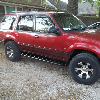Doug904
Sponsor
- Joined
- March 30, 2001
- Messages
- 534
- Reaction score
- 1
- City, State
- Jasper, Alabama
- Year, Model & Trim Level
- 2005 Roush GT
Hey guys,
Here's a guy who's sent me his tuner in for me to fine tune it for him. His a/f is kinda lean at an average of 13.8-14.4 but he also added a Volant air intake after he got his tuner from me. I've seen the most changes using a Volant air intake so in my book they are good, expensive yes but they do make a difference.
He's made 194.8 rwhp and 218.8 rwtq. His mods include the Volant, Cat-back exhaust and JBA plug wires. With a richer a/f ratio he'll be at the 200rwhp mark too. This guy is in Texas and I wasn't able to goto the dyno with him but I'm also sending him a Raptor Datalogger so he can check his sensors and ensure he's not activating the knock sensor.
This dyno graph also shows that the dyno lost a RPM signal for a brief second from 70mph to about 90mph but even without the graph the numbers are still the same. This is shown on the torque line.
Thanks, Doug.
Coy Miller's 2001 Ranger
Here's a guy who's sent me his tuner in for me to fine tune it for him. His a/f is kinda lean at an average of 13.8-14.4 but he also added a Volant air intake after he got his tuner from me. I've seen the most changes using a Volant air intake so in my book they are good, expensive yes but they do make a difference.
He's made 194.8 rwhp and 218.8 rwtq. His mods include the Volant, Cat-back exhaust and JBA plug wires. With a richer a/f ratio he'll be at the 200rwhp mark too. This guy is in Texas and I wasn't able to goto the dyno with him but I'm also sending him a Raptor Datalogger so he can check his sensors and ensure he's not activating the knock sensor.
This dyno graph also shows that the dyno lost a RPM signal for a brief second from 70mph to about 90mph but even without the graph the numbers are still the same. This is shown on the torque line.
Thanks, Doug.
Coy Miller's 2001 Ranger











